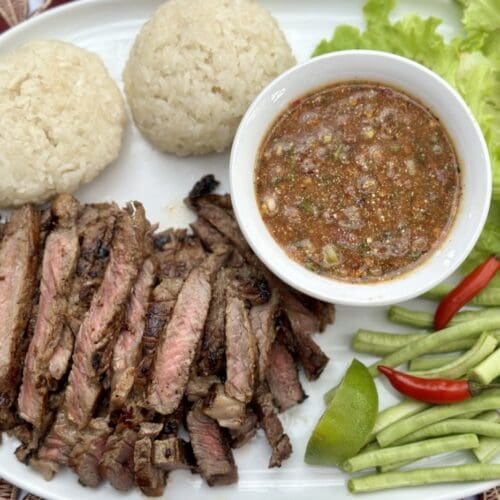
Crying Tiger (Thai beef steak with Nam Jim Jaew dipping sauce)
Sliced marinated steak served with spicy dipping sauce. You can easily recreate this tasty and traditional Thai dish, Crying Tiger, at home
Video
Ingredients
- 500gm / 1.1lb grilling steak (NOTE 1)
- 2 tbsp (40ml / 1.4floz) vegetable or canola oil
FOR THE MARINADE
- 2 garlic cloves (minced)
- 1 tbsp (20ml / 0.7floz) oyster sauce (NOTE 2)
- 2 tsp (10ml / 0.3floz) light soy sauce (NOTE 3)
- 2 tsp (10ml / 0.3floz) fish sauce (NOTE 4)
- 1 tsp white sugar
- ¼ tsp freshly ground black pepper
FOR NAM JIM JAEW DIPPING SAUCE
- 2 tbsp (40gm / 1.4oz) raw glutinous or sticky rice (NOTE 5)
- ⅓ cup (80ml / 2.7fl oz) fish sauce
- 2 tbsp (40ml / 1.4floz) tamarind puree (NOTE 6)
- 1 tbsp (20ml / 0.7floz) fresh lime juice
- 40gm / 1.4oz finely chopped palm sugar (or brown sugar) (NOTE 7)
- 2 to 4 tsp dried chilli flakes (adjust to taste) (NOTE 8)
- 1 tbsp (12gm / 0.4oz) finely chopped shallots
- 1 tbsp (10gm / 0.3oz) thinly sliced spring onions or scallions
- 1 tbsp (6gm / 0.2oz) finely chopped coriander or cilantro
Instructions
- Mix all the marinade ingredients together in a small bowl, then rub it all over the steaks. Cover the steaks and leave to marinate in the fridge for up to 2 hours or overnight.
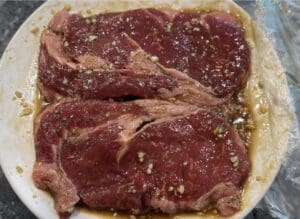
- When it's time to cook the steaks, take them out of the fridge and let them sit at room temperature for 15 to 30 minutes (depending on your kitchen climate). Doing this will help the steaks cook faster and more even. On high heat, heat oil in a large frying pan until it smokes. Shake of any excess marinade from the steaks and place them in the pan. For medium cooked steaks, fry each side of the steak for 2 to 3 minutes or adjust cooking time to your liking. Transfer the steaks to a cooling rack and allow them to rest for 5 minutes before slicing them into thin strips. Refer to the notes below for the temperature guide for cooking steak. You could also grill, broil or BBQ the steaks.
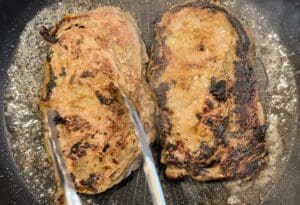
- Nam Jim Jaew dipping sauce - Heat small frying pan over medium high heat, then add in the rice. Fry the rice over high heat for 3 to 5 minutes until it becomes fragrant or turns a golden brown colour. Ensure the rice doesn't burn by shaking the pan or stir the rice frequently. Leave to rice to cool for a few minutes, then use a spice grinder or mortar and pestle to grind the roasted rice into a powdery consistency.
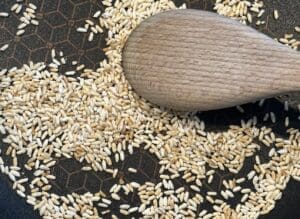
- In a bowl, combine the fish sauce, tamarind, lime juice and palm sugar, then stir until most of the sugar dissolves. Stir in the ground roasted rice into the sauce until well combined, then stir in the dried chillies, shallots, coriander and green onion. Taste the sauce and adjust the flavour balance according to your taste, such as adding sugar for increased sweetness or tamarind for a tangier taste.
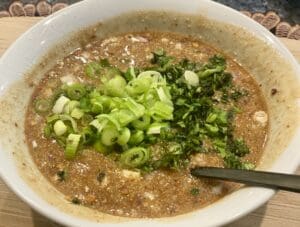
Notes
(NOTE 1) Steak - In Thailand, steak is enjoyed chewy rather than tender, and it is usually prepared no rarer than medium. I understand that the best way to cook a steak can spark heated debates, so cook it to your liking. I opted for scotch fillets (rib eye), although you could use more affordable cuts like rump, sirloin, flank, or any grilling steak you prefer. Internal steak temperature guide (during cooking, not when resting) Rare: 48ºC / 118ºF Medium rare: 52ºC / 125ºF Medium: 58ºC / 136ºF Medium well: 62ºC / 143ºF Well done: 68ºC / 154ºF
(NOTE 2) Oyster sauce - Despite its name, oyster sauce does not have a strong oyster or fishy flavour. Oyster sauce adds a depth of flavour to dishes and has a rich, savoury and slightly sweet flavour profile. Find oyster sauce by looking in the international section at a supermarket or visit an Asian grocer.
(NOTE 3) Light soy sauce (or regular soy sauce), but don't swap for dark or sweet soy sauce varieties, as these aren't interchangeable. Find soy sauce by looking in the international section at a supermarket or visit an Asian grocer.
(NOTE 4) Fish sauce - My favourite brand is Thai 'Squid' fish sauce, but any brand of fish sauce would work. Despite its strong fish odour, fish sauce imparts a distinctive savoury taste to dishes. Find fish sauce by looking in the international section at a supermarket or visit an Asian grocer.
(NOTE 5) Raw glutinous or sticky rice - In its raw form, glutinous rice appears short with opaque grains that look chalky. Unlike regular rice, glutinous rice has a higher starch content, which makes it sticky when cooked. If you can't find sticky rice, use the same amount of raw jasmine rice as a substitute. Look for Thai or Vietnamese glutinous rice at an Asian grocer.
(NOTE 6) Tamarind puree - (tamarind concentrate or paste) has a distinct sweet and sour taste. They're sold in firm blocks with seeds, which need to be soaked, then strained before using. For convenience, I like to use tamarind in puree. Find tamarind puree by looking in the international section at a supermarket or visit an Asian grocer.
(NOTE 7) Palm sugar is made from the sap of the coconut palm tree, so there's no need to harvest the tree, which means it's sustainable. Look at the ingredients on the label to make sure you're buying 100% palm sugar for that original caramel taste. If you don't have palm sugar, you can replace it with the same amount of brown sugar.
(NOTE 8) Dried chilli flakes - The spiciness of dried chilli flakes can vary from mild to extra spicy, so add a teaspoon to the dipping sauce and taste before adding more.
I've used a third-party application to calculate the calories and nutritional information, so please use this as an approximate guide only.
Cooking measurements are in Australian standard spoon and cup measurements. For specific details and conversions, visit our Australian Cooking Measurements page.
Nutrition
Serving: 1 ServingCalories: 620kcalCarbohydrates: 44gProtein: 56gFat: 55gSaturated Fat: 17gPolyunsaturated Fat: 7gMonounsaturated Fat: 29gTrans Fat: 0.1gCholesterol: 153mgSodium: 4203mgPotassium: 1008mgFiber: 2gSugar: 17gVitamin A: 898IUVitamin C: 7mgCalcium: 73mgIron: 6mg